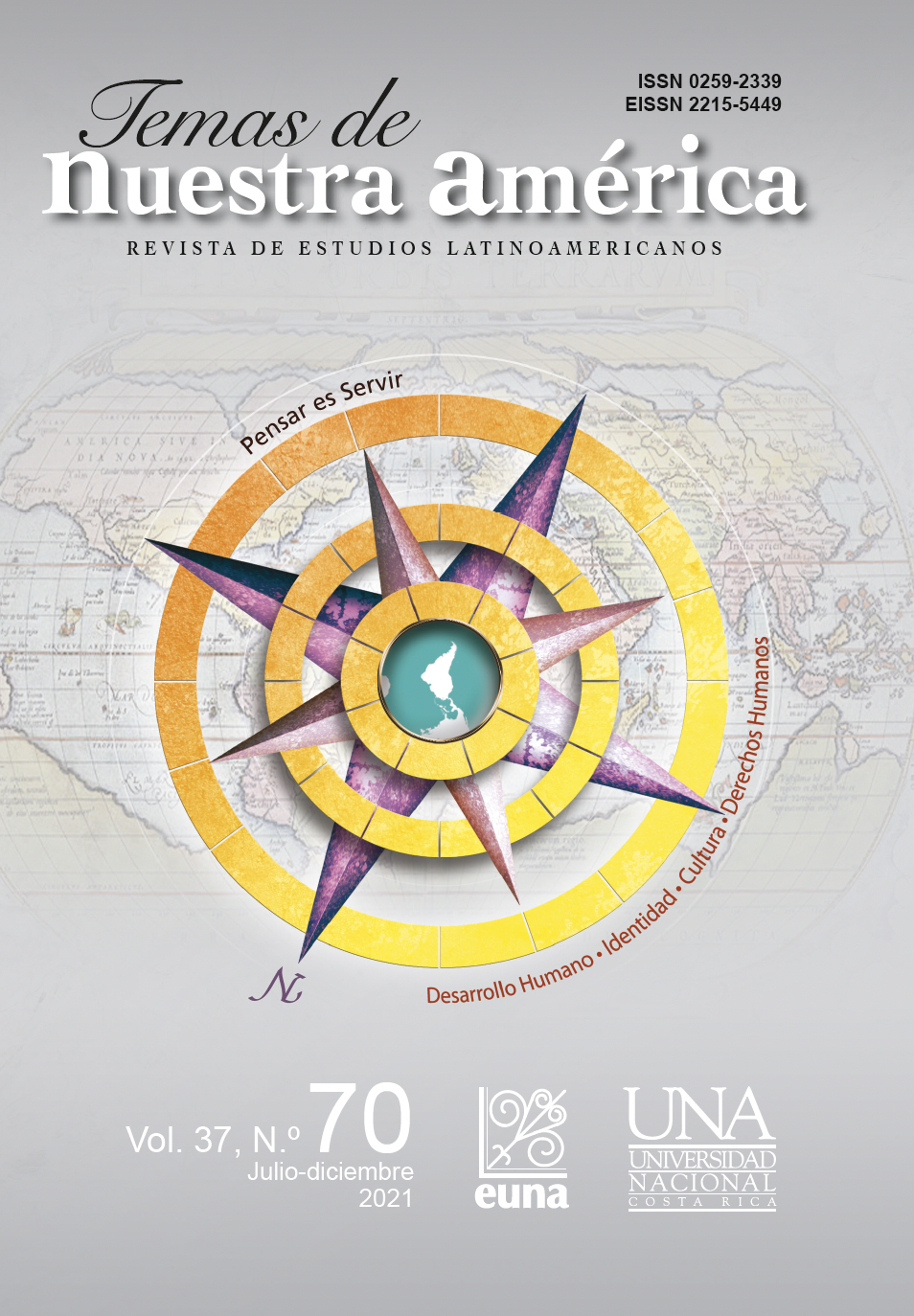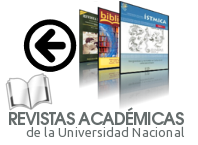Memoria y globalización de una huaca en el Perú: los inicios de la iconización de Machu Picchu (1910-1915)
DOI:
https://doi.org/10.15359/tdna.37-70.6Keywords:
Machu Picchu, globalization, memory, travel narratives, modernityAbstract
This article addresses the beginning of the modern construction processof th e icon par excellence of cultural, territorial and national memory that is emblematic of globality for Peru: Machu Picchu. To this end, it proposes the record of the symbolic-cultural genealogy that has given rise to the Andean-Amazonian icon in the early twentieth century, from a critical interpretation that interrelates travel chronicles, reports of scientific expeditions, naturalistic and visual catalogs, as well as journalistic narratives and textualities linked to the growing tourism industry. From the analysis of the emergence of the story of the “discovery” of a “lost city”, the article analyzes the data on which this story is based and the objectives with which it was articulated since 1910 with the series of scientific and archaeological expeditions to the region of Cuzco.
References
Ainsworth Means, Philip (1938) “The Incas: Empire Builders of the Andes”. En: The National Geographical Magazine, Washington D.C., Vol. LXXIII, N°2, February 1938, pp. 225-264.
Bingham, Alfred M. (1989) Portrait of an Explorer. Hiram Bingham, discoverer of Machu Picchu. Iowa State: University Press/Ames.
Bingham, Hiram (1908). 'The possibilities of South American History and Politics as a Field Research". International Bureau ofthe American Republics, (Washington D.C.) Feb.
Bingham, H. (1909). "Causes of the Lack of Political Cohesion in Spanish America", The American Political Science Review, (Washington D.C.) IV, 4, noviembre.
Bingham, H. (1910). Across South America. Án Account of a Journey from Buenos Aires to Lima by Way of Potosi, with Notes on Brazil, Argentina, Bolivia, Chile, and Peru. Boston/Nueva York: El Riverside Press Cambridge, 1911.
Bingham, H. (1912 a) "Preliminary Report of the Yale Peruvian Expedition". Bulletin for the American Geographical Society, XLIV, enero.
Bingham, H. (1912 b).“Discurso de incorporación a la Facultad de Letras y Filosofía de la Universidad del Cuzco”. En: Revista Universitaria, Cuzco, Año I, N°2, setiembre, pp. 24-27.Bingham, H. (1913). "In the Wonderland of Peru", The National Geographic Magazine, (Washington. D.C.), XXIV, 4.
Bingham, H. (1922). Inca Land: Explorations in the Highlands of Peru. Segunda edición. Boston: Houghton Mifflin.
Bingham, H. (1930). Machu Picchu, A Citadel of the Incas. New York : Hacker Art Books, reimpresión facsimilar. 1979.
Bingham, H. (1942). "lncalandia, ("Inca Land": Tierra del Inca.- El país de los Incas), Exploración en las tierras altas del Perú", en: Boletín del Centro Geográfico del Cuzco, año 1,no. l, pp. 33-65; (Cuzco), Editorial Rozas Sucesores. Traducción y notas por Federico Ponce de León de: Inca Land, Boston, 1922.
Bingham, H. (1948). Machu Picchu la ciudad perdida de los incas. Traducción de Emilia Romero. Santiago de Chile-Madrid: 7° edición, 1972.
Bingham, H. (2004). Machu Picchu. Unveling the Mystery of the Inca. New Haven y Londres: Yale University Press.
Breining, Helmbrecht (2000).“America and the Americas: Self-Assertion and Self-Questioning in U.S.-American Writing on Latin America.” En: Hagebbüche, Roland & Raab, Josef eds., Negotiations of America´s National Identity.Tübingen: Stauffenburg Verlag, Vol. II.
Canziani, José (2009). Ciudad y territorio en los Andes. Lima: Fondo Editorial Pontificia Universidad Católica del Perú.
Colby, Jason M. (2011). The Business of Empire: United Fruit, Race, and U. S. Expansion in Central America. Ithaca: Cornell University Press.
DECRETO SUPREMO 116-2010-PCM. En: Diario El Peruano, 31.12.2010.
Eaton, George (1990) [1916] La colección del material osteológico de Machu Picchu, New Haven. Traducción y edición de Sonia Guillén Oneeglio, 1990. Lima: Sociedad de Arqueología Andina.
Fifer, Valerie (1999). United States perceptions of Latin America 1850-1930. A ´New West´South of Capricorn? Manchester and New York: Manchester University Press.GENERAL PLAN OF WORK FOR THE YALE EXPEDITION TO PERU (1911). Manuscrito perteneciente a la colección Yale Peruvian Expeditions, de la Sterling Library - Yale University, New Haven, USA.
Göhring, Hermann (1877) Informe al Gobierno del Perú sobre una expedición a los valles
de Paucartambo en 1873. Lima: Imprenta del Estado.
Grosvenor, Gilbert (1957) The National Geographic Society and its Magazine.Washington, D.C.: National Geographic Society. Harvey, D.(1993) Condição Pós-Moderna. São Paulo: Loyola.
Harvey, D. (2005). A produçao capitalista do espaço. Sao Paulo: Annablume.
Harvey, D. (2001). Spaces of Capital: Towards a Critical Geography. Edinburgh: Edinburgh University Press.
Hewett, Edgar L., (1911) “Report to the Managing Committee of the School of American Archaeology, 1910”, en Bulletin of the Archaeological Institute of America. 2:1, pp. 15-27.
Hewett, Edgar L., (1912b) “The Excavations at Quirigua”, Bulletin of the Archaeological Institute of America. 3, pp. 163-171.
Hewett, Edgar L., (1915) “Ancient America at the Panama-California Exposition”, en Art and Archaeology. 2:3, pp. 65-90.
Kimberley, H. (2017). A Woman's Place Is at the Top: A Biography of Annie Smith Peck, Queen of the Climbers. New York: St. Martin's Press.
Krizowá, M. (2019). “Retorno de la civilización” a Quiriguá: Arqueología maya y los juegos de poder y prestigio en Centroamérica en los siglos XIX y XX”, en EntreDiversidades. 2:13, pp. 171-202.
Lerner, Jesse, (2005) “The Paradoxes of Quiriguá”, en Journal of Film and Video. 57:1-2, pp. 78–83.
López Lenci, Yazmín, et al. (2005). “Machupicchu, lugar sagrado versus marca registrada de una cultura globalizada”, en: Machupicchu. Historia, sacralidad e identidad. Cuzco, Instituto Nacional del Cultura INC. Pp. 149-157.
López Lenci, Yazmín (1999). El laboratorio de la vanguardia literaria en el Perú. Lima: Editorial Horizonte.
Lumbreras, Luis, et al. (2005) [2003]: Machupicchu. Historia, Sacralidad e Identidad. Cuzco. Pp. 14-41
Lumbreras, L. (1974). La arqueología como ciencia social. Lima: Ediciones Histar.
Lumbreras, L. (2004). "Editorial ". Gaceta Cultural del Perú. Lima: INC. Nº 4. Diciembre.
Markham, Sir Albert H. (1917). The Life of Sir Clements R. Markham. Londres: John Murray, Albermarle St.
Markham, Clements R. (1862). Travels in Perú and India, while superintending the collection of chinchona plants and seeds in South America and their introduction into India. Londres: John Murray, Albemarle Street.
Markham, Clements R. (1910). “The Land of the Incas". The Royal Geographical Journal. VOL. XXXVII, N. 4. 381 - 404. Octubre. Incluye mapa. Londres: The Royal Geographical Society.
Matarredona, Nuria (2021). “Quiriguá 1910-1914: un punto de inflexión en la conservación del patrimonio arquitectónico maya”, en Gremium 15.
McCarry, Charles (1989). “Let the world hear from you.” En: National Geographic Index 1888-1988. Washington, D.C.: National Geographic Society.
Morley, Sylvanus G. (1912). “Quirigua, an American Town 1400 Years Old: Glimpses of an Extinct American Civilization”, en Scientific American. 107:5, pp. 96-97, 105.
Morley, S. (1913). “Excavations at Quiriguá, Guatemala”, en National Geographic. 24:3, pp. 339-361.
Morley, S. (1936) Guía de las ruinas de Quiriguá, trad. Adrián Recinos. Washington: Carnegie Institution.
Mould de Pease, Mariana (2003). Machu Picchu y el Código de Ética de la Sociedad de Arqueología Americana: una invitación al diálogo intercultural. Lima: Instituto Nacional de Cultura, Consejo Nacional de Ciencias y Tecnología, Universidad Nacional San Antonio Abad del Cuzco, Pontificia Universidad Católica del Perú.
Nora, Pierre (1984). Les Lieux de Memoire 1. Paris. Gallimard.
O´Sullivan, John L. (1998). “The Great Nation of Futurity”. En: Thomas Inge ed., A Nineteenth-Century American Reader. Washington: United States Information Agency. Págs. 4 – 6.
Pratt, Mary Louise (2010). Ojos imperiales. Literatura de viajes y transculturación. México: Fondo de Cultura Económica.
Ricoeur, Paul (2004). La memoria, la historia el olvido. Traducción del francés por Agustín Neira. México: Fondo de Cultura Económica.
Rostworowski, María (2001). Pachacutec (1953). Obras Completas l. Lima: Instituto de Estudios Peruanos.
Rowe, John H. (1987). "Machu Picchu a la luz de los documentos del siglo XVI". Kuntur Wasi, Lima, 4, 12-20.
Rowe, J. (1990). "Machu Picchu a la luz de los documentos del siglo XVI". Histórica. Lima, 14:139-54.
Rowe, J. (2003). Los Incas del Cuzco. Siglos XVI - XVII - XVI 11. Jorge Flores Ochoa (ed.) Cuzco: Revista del Instituto Nacional de Cultura.
Sands, W. F., (1913) “Mysterious Temples of the Jungle: The Prehistoric Ruins of Guatemala”, en National Geographic. 24:3, pp. 325-338.
Schávelzon, Daniel, (1988), “Las excavaciones en Zaculeu (1946-1950): una aproximación al análisis de la relación entre arqueología y política en América Latina“, en Nicholas J. Saunders - Olivier de Montmollin (eds.), Recent Studies in pre-Columbian archaeology. Oxford: Univeristy of Oxford Press. T. 1, pp. 167-190.
Schoonover, Thomas David, (1991) The United States in Central America, 1860 - 1911: episodes of social imperialism and imperial rivalry in the world system. Durham: Duke University Press
Sharer, Robert J. y Loa P. Traxler, (2012) “Copan and Quirigua: Shifting Destinies in the Southeastern Maya Lowlands”, en Contributions in New World Archaeology. 4, pp. 139-156.
Soja, E. W. (2000). Postmetropolis. Critical Studies of Cities and Regions. Oxford: Blackwell)
Soja, E. (2009) [2008]. Warf, Barney & Santa Arias. The Spatial Turn: Interdisciplinary Perspectives. London and New York: Routledge.
Squier, Efraim George (1877) Peru: ln cidents of' Travel and Explorarion in the Land ofthe Incas. New York: Harpers Brothers.
Squier, E. (1974). Un viaje por tierras incaicas: crónica de una expedición arqueológica. Lima: Universidad Nacional Mayor de San Marcos.
Stephens, John Lloyd, (1971) [1841]. Incidentes de Viaje en Centroamérica, Chiapas y Yucatán, trad. Benjamin Mazariegos Santizo. San José: Editorial Universitaria Centroamericana. 2 vols.
Taussig, Michael (1987). Shamanism, Colonialism and the Wild Man. Chicago and London: The University of Chicago Press.and London: Routledge.
Trachtenberg, Alan (2000). “Imaginary Indians and American Identity: The Wanamaker Expeditions, 1908-1913”. En: Negotiations of America´s National Identity. Pp. 283-302.
Valcárcel, Luis E. (1981). Memorias. Lima: Instituto de Estudios Peruanos (IEP).
Valcárcel, Luis E. (1942). Cuzco. Lima: Banco de Crédito
Valcárcel, Luis E, (1967). Etnohistoria del Perú antiguo. Lima: Universidad Nacional Mayor de San Marcos.
Published
How to Cite
Issue
Section
License
Esta obra de Revista Temas de Nuestra América está bajo una Licencia Creative Commons Atribución-NoComercial-SinDerivar 4.0 Internacional.
Cualquier permiso que trascienda dicha licencia, debe solicitarse por escrito a la persona directora de la Revista










